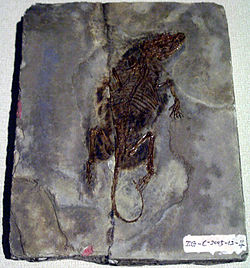Symmetrodont
| Symmetrodonta Temporal range: Early Cretaceous–Campanian Possible Paleocene ghost lineage |
|
|---|---|
 |
|
| Fossil specimen of Zhangheotherium quinquecuspidens | |
| Scientific classification | |
| Kingdom: | Animalia |
| Phylum: | Chordata |
| Clade: | Synapsida |
| Class: | Mammalia |
| Clade: | Trechnotheria |
| Order: | †Symmetrodonta |
| Subgroups | |
Symmetrodonta is a group of Mesozoic mammals and mammal-like synapsids characterized by the triangular aspect of the molars when viewed from above and the absence of a well-developed talonid. The traditional group of 'symmetrodonts' ranges in age from the latest Triassic to the Late Cretaceous. Most research during the 21st century has concluded that they do not represent a discrete phylogenetic category. However, the name is still used informally by some researchers for convenience, or restricted to the spalacotheriids and zhangheotheriids.
At least symmetrodonts with acutely-triangulated molar cusps (“acute-angled symmetrodonts”) seem to form a true monophyletic group, and lasted from the Early Cretaceous to the Campanian, although Zhangheotheriidae might be paraphyletic in relation to other forms.Chronoperates has been suggested to be a late surviving representative of this clade, offering a ghost lineage extending to the late Paleocene; however, no recent phylogenetic studies have incorporated it.
Particular sub−groups of Symmetrodonta are better studied, e.g. Spalacotheriidae, which has acute−angled molariform teeth, strongly reduced talonids, and conspicuous anterior and posterior cingulids.
Though some forms like Zhangheotherium retain a Meckelian groove, at least Spalacotheriidae lost it, acquiring modern ear anatomy. Their deciduous canines and premolars as well as long lower jaw indicate a carnivorous/insectivorous diet.
...
Wikipedia
